The ADATA SWORDFISH is the company’s latest consumer-grade SSD. Featuring the PCIe Gen3x4 interface via the usual M.2 2280 form factor, the Swordfish is equipped with 3D NAND Flash and comes in capacities ranging from 250GB to 2TB. Like most ADATA consumer drives, the company focuses more on price over performance (specifically in writes), which allows those with a small budget to upgrade their system to the speedy NVMe interface. The ADATA Swordfish certainly falls in this category.
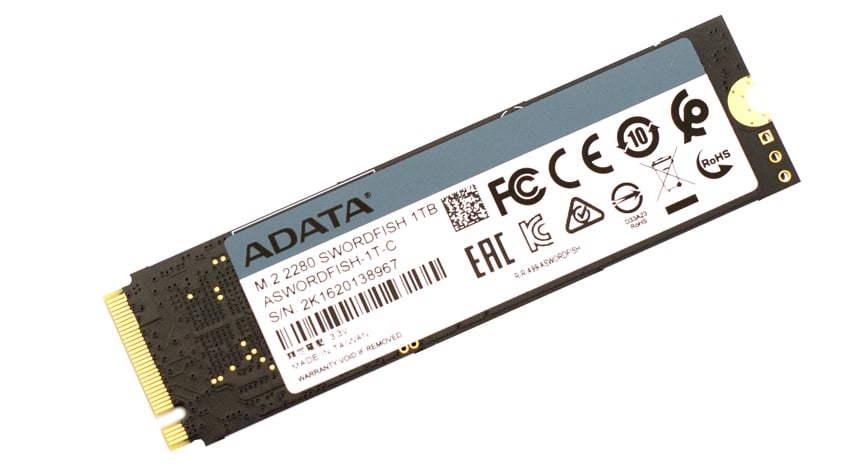
ADATA has equipped the their new SSD with LDPC (Low-Density Parity-Check) error correcting code technology support, which allows the drive to detect and fix errors to help promote data integrity and therefor an extended lifespan. In addition, it features the usual AES 256-bit encryption to help safeguard data via password-protection.

Performance-wise, the ADATA Swordfish is quoted to deliver read and write speeds up to 1,800MB/s and 1,200MB/s, respectively, while random 4K performance is expected to reach up to 180,000 IOPS in both read and writes. The Adata Swordfish also comes with a nice-looking etched aluminum heatsink, which is something you don’t often see on consumer drives. This will certainly help it stay cool during intensive tasks like gaming or video encoding.
Backed by a 5-year warranty, the Adata Swordfish comes in capacities of 250GB, 500GB, 1TB, and 2TB. We will be looking at the 1TB model for this review.
ADATA Swordfish Specifications
| Capacity | 250GB / 500GB / 1TB / 2TB |
| Form Factor | M.2 2280 |
| NAND Flash | 3D NAND |
| Dimensions (L x W x H) | 80 x 22 x 3.85mm |
| Weight | 10.5g / 0.37oz |
| Interface | PCIe Gen3x4 |
| Sequential R/W performance (max.) | Up to 1800/1200MB/s |
| Operating Temperature | 0°C – 70°C |
| Storage Temperature | -40°C – 85°C |
| Shock Resistance | 1500G/0.5ms |
| MTBF | 1,800,000 hours |
| Warranty | 5-year limited |
Adata Swordfish Performance
Testbed
The test platform leveraged in these tests is a Dell PowerEdge R740xd server. We measure SATA performance through a Dell H730P RAID card inside this server, although we set the card in HBA mode only to disable the impact of RAID card cache. NVMe is tested natively through an M.2 to PCIe adapter card. The methodology used better reflects end-user workflow with the consistency, scalability and flexibility testing within virtualized server offers. A large focus is put on drive latency across the entire load range of the drive, not just at the smallest QD1 (Queue-Depth 1) levels. We do this because many of the common consumer benchmarks don’t adequately capture end-user workload profiles.
Houdini by SideFX
The Houdini test is specifically designed to evaluate storage performance as it relates to CGI rendering. The test bed for this application is a variant of the core Dell PowerEdge R740xd server type we use in the lab with dual Intel 6130 CPUs and 64GB DRAM. In this case, we installed Ubuntu Desktop (ubuntu-16.04.3-desktop-amd64) running bare metal. Output of the benchmark is measured in seconds to complete, with fewer being better.
The Maelstrom demo represents a section of the rendering pipeline that highlights the performance capabilities of storage by demonstrating its ability to effectively use the swap file as a form of extended memory. The test does not write out the result data or process the points in order to isolate the wall-time effect of the latency impact to the underlying storage component. The test itself is composed of five phases, three of which we run as part of the benchmark, which are as follows:
- Loads packed points from disk. This is the time to read from disk. This is single-threaded, which may limit overall throughput.
- Unpacks the points into a single flat array in order to allow them to be processed. If the points do not have dependency on other points, the working set could be adjusted to stay in-core. This step is multi-threaded.
- (Not Run) Processes the points.
- Repacks them into bucketed blocks suitable for storing back to disk. This step is multi-threaded.
- (Not Run) Writes the bucketed blocks back out to disk.
Here, we see the ADATA Swordfish with a score of 3,019.1 seconds, which ranked near the bottom of the pack just behind the WD Black drive.
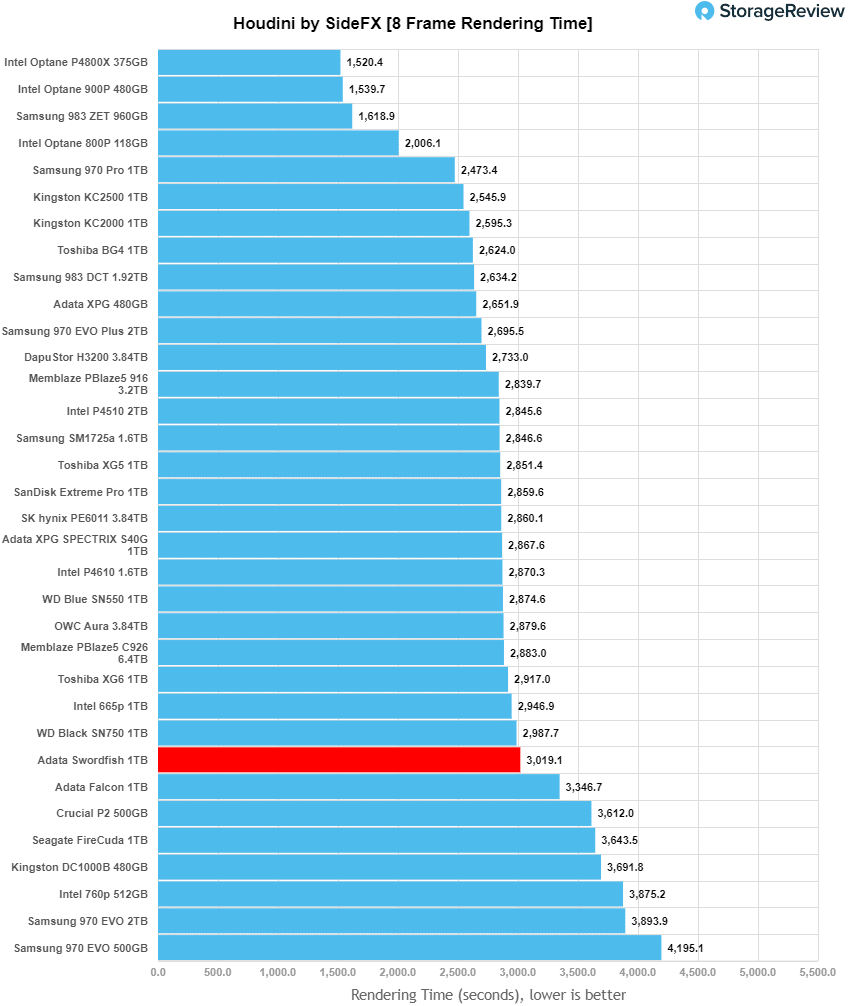
VDBench Workload Analysis
When it comes to benchmarking storage devices, application testing is best, and synthetic testing comes in second place. While not a perfect representation of actual workloads, synthetic tests do help to baseline storage devices with a repeatability factor that makes it easy to do apples-to-apples comparison between competing solutions. These workloads offer a range of different testing profiles ranging from “four corners” tests, common database transfer size tests, to trace captures from different VDI environments. All of these tests leverage the common vdBench workload generator, with a scripting engine to automate and capture results over a large compute testing cluster. This allows us to repeat the same workloads across a wide range of storage devices, including flash arrays and individual storage devices. Our testing process for these benchmarks fills the entire drive surface with data, then partitions a drive section equal to 5% of the drive capacity to simulate how the drive might respond to application workloads. This is different than full entropy tests which use 100% of the drive and take them into steady state. As a result, these figures will reflect higher-sustained write speeds.
Profiles:
- 4K Random Read: 100% Read, 128 threads, 0-120% iorate
- 4K Random Write: 100% Write, 64 threads, 0-120% iorate
- 64K Sequential Read: 100% Read, 16 threads, 0-120% iorate
- 64K Sequential Write: 100% Write, 8 threads, 0-120% iorate
Comparables for this review:
- ADATA Falcon 1TB
- WD Blue SN550 1TB
- Samsung EVO Plus 2TB
- Kingston KC2500 1TB
- WD Black 1TB
- Seagate FireCuda 510 1TB
For 4K performance, the ADATA Swordfish was the only drive that couldn’t stay below a millisecond throughout the test, which occurred roughly around just past the 100K mark. The drive peaked at just 106,256 IOPS with a very high latency of 1,073µs.
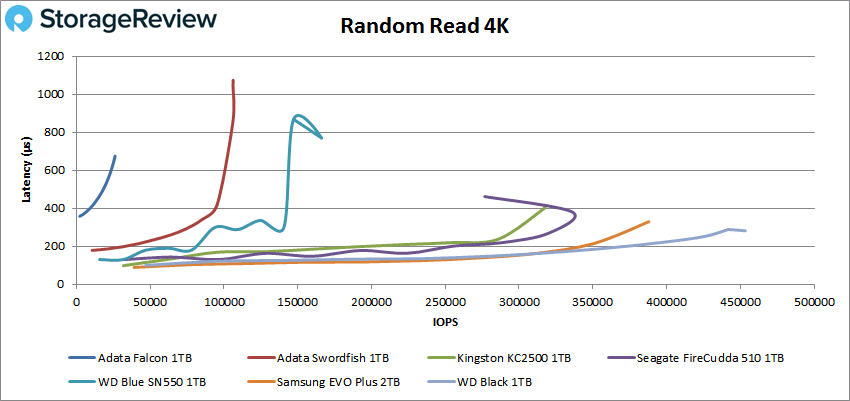
For 4K random write, you can see that the ADATA Swordfish basically stopped performer soon after we started the test, reaching a peak of just 9,710 IOPS at a latency of 13,191µs. The other ADATA drive followed suit.
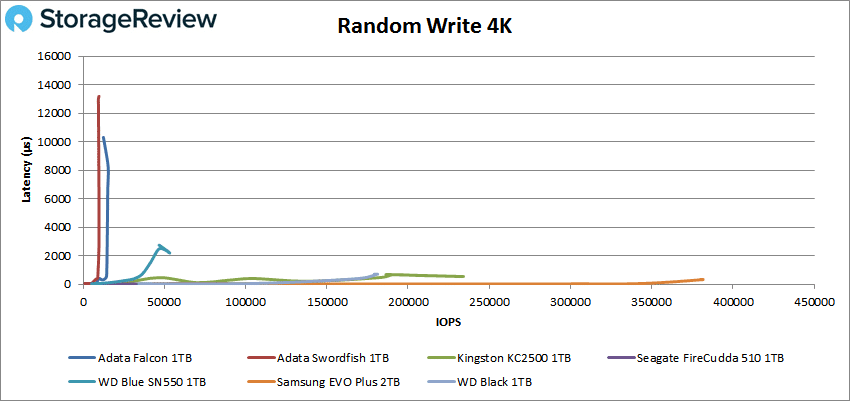
With 64K sequential performance, the ADATA Swordfish showed performance under 1 millisecond throughout the test. It went on to peak at 26,768 IOPS (or 1.68GB/s) with 596µs.
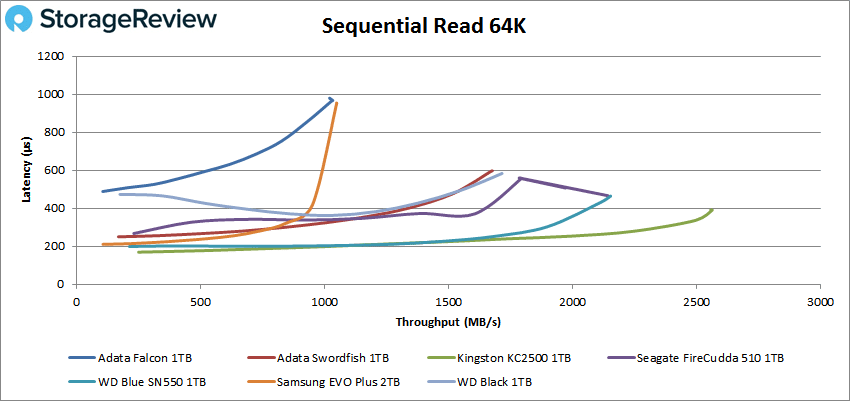
The ADATA Swordfish continued to show slow write performance when with 64K sequential, peaking at just 2k IOPS (or 130MB/s) at 7,984ms.
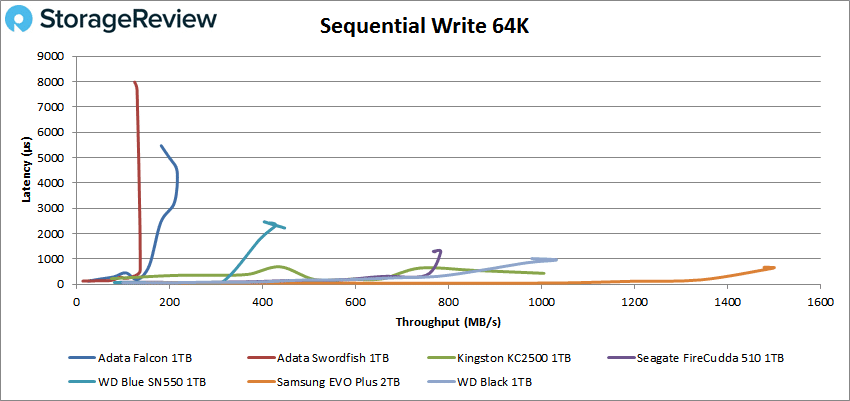
Next, we looked at our VDI benchmarks, which are designed to tax the drives even further. Like in the tests above, the Adata drives really struggled. This is unsurprising, as lower end drives usually perform very poorly during write workloads in our tests. Regardless, these tests include Boot, Initial Login, and Monday Login.
In Boot, the ADATA Swordfish showed a peak of 35,679 IOPS with a latency of 972.9µs before it took a hit in latency and IOPS at the end.
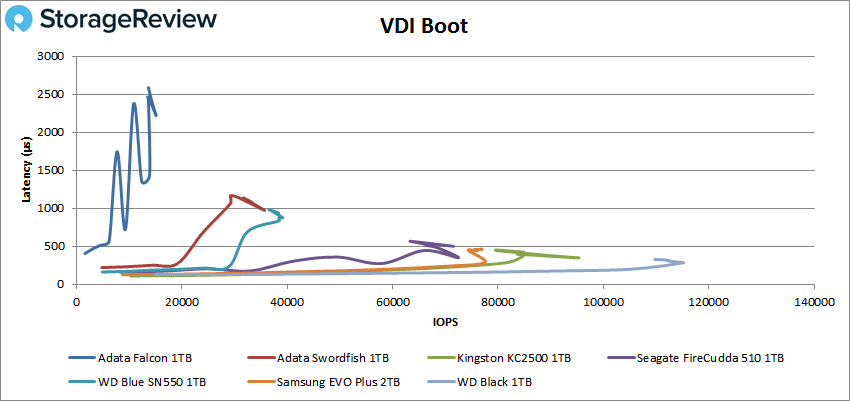
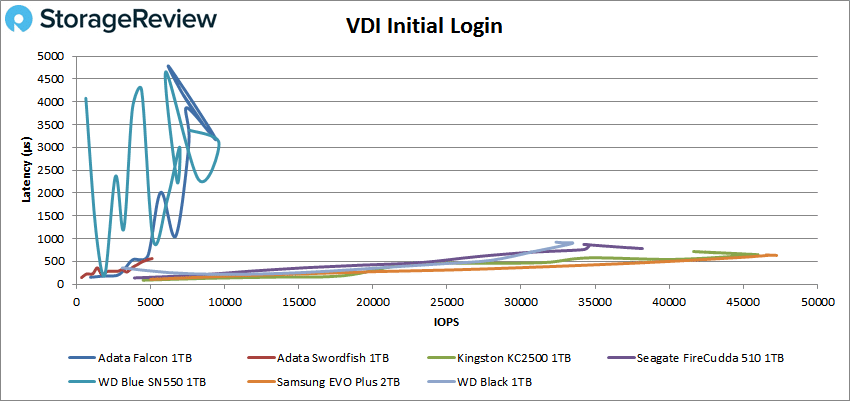
Finally, in our last test, VDI Monday Login showed the ADATA Swordfish with a peak IOPS at around 8,086 IOPS with just a hair under 2ms in latency before experience another spike in performance at the end of the test.
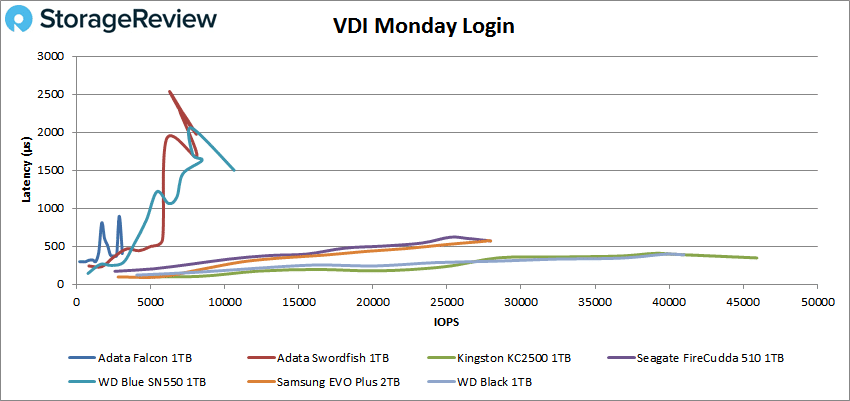
Conclusion
The ADATA Swordfish is an entry-level NVMe SSD that supports the PCIe Gen3x4 interface via the M.2 2280 form factor. It is outfitted with 3D NAND Flash and is available in capacities up to 2TB. The ADATA Swordfish also features Low-Density Parity-Check error correcting and the usual AES 256-bit encryption technology. As demonstrated in our performance charts (specifically referring to its write performance), the Swordfish is only meant as an upgrade for those looking for an affordable NVMe drive to install their OS from a SATA-based HDD or SSD, or as an inexpensive supplemental storage solution for PC games.
Highlights of its performance include: 106,256 IOPS in 4K read, 9,710 IOPS IOPS in 4K write, 1.68GB/s in 64K read, and 125MB/s in 64K write. In our VDI Clone, we saw 35,679 IOPS in boot, 5,106 IOPS in initial login, and 8,086 IOPS in Monday login.
Though these results couldn’t keep up with the other tested consumer drives, it was expected. Entry models like the ADATA Swordfish tend to perform very poorly during our write workloads, which is why you saw IOPS drops and latency spikes all over the place in our charts. ADATA’s consumer line is focused on building affordable drives with decent read performance at a lower cost than SSD lines like the Samsung EVO. The 250GB model is priced at just $40, while the Samsung EVO Plus goes for roughly $75 as of the date of this review. However, the 1TB model is currently $115 roughly $75 lower than the Samsung EVO Plus 1TB (though, it is currently on sale). So if performance is not the main goal the price may be right for day to day users.




 Amazon
Amazon